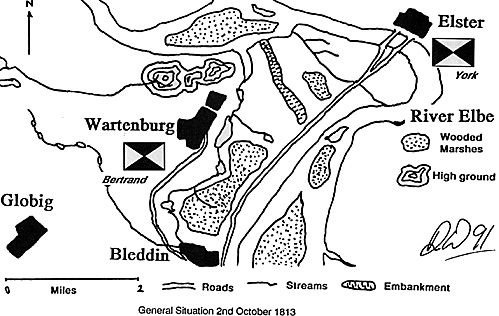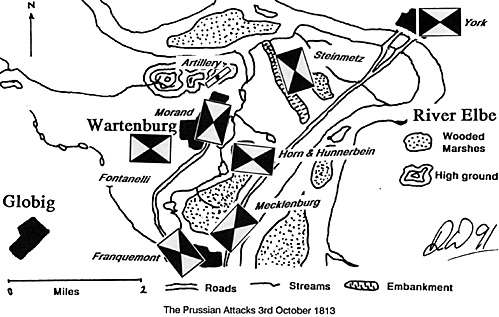On 1st October 1813, following his defeat at Dennewitz, Marshal Ney , commanding the French IV and VII Corps, ordered Bertrand and IV Corps to Wartenburg. The order was intended to prevent the Allied arn-iies crossing the Elbe River, and severing Ney's lines of communication with Dresden.
The village of Wartenburg was located in a loop of the Elbe and was sited amiddst marshy ground interlaced with numerous backwaters. Between the village was an embankment to protect it from the frequent high flooding of the Elbe.
As can be seen from the map 1. the area was generally unsuitable for manoeuvre, the only 'easy' access to Wartenburg being along the road running from the bridges to the village of Bleddin.
This road itself presented an obstacle byway of the bottle neck created by the southern most tip of the embankment and the west bank of the Elbe. The gap being no more than a few hundred yards wide.
On 2nd October Bertrand arrived at Wartenburg and found himself before the Prussian held bridges Bertrand having previous knowledge of the area felt confident that he could prevent the Prussians from passing Wartenburg. He accordingly deployed Morand's division in and around Wartenburg. Fontanelli's Division was deployed in support Franquemont's Wurtemburg Division was deploye( at Bleddin to prevent an outflanking manoeuvrs against the French right flank. The French Reserve artillery was deployed on the heights to the north of Wartenburg where it could sweep the flat ground between the embankment and the east face of Wartenburg, this ground was also covered by the remaining artillery, excluding Franquemont's.
On the right bank of the Elbe was deployed the Prussian Army of Silesia, lead by Blucher. Bertrand was blissfully unaware that he was to be facing an Army if over 64,000 men and that in terms of attrition it was impossible for him to hold his position.
On the other hand the Prussian had no idea of the poor terrain conditions with the Wartenburg Peninsula, simply because they had not bothered to look. They presumably anticipated an unopposed crossing.
By the end of the 2nd October, the Prussian Army was up, and it was decided to cross the Elbe. The task of storming Wartenburg was given to York's I Corps.
Prussian Advance
At 7.00am 3rd October the Prussian advance began. The first troops across the bridges were the brigade of Prince Karl of Mecklenburg. Prince Karl had been ordered to march directly on Wartenburg, however it was not long before this sensible officer realised that such an assault was not possible owing to the terrain, and that he must go round the southern tip of the embankment, he halted his advance. Prince Karl was faced with the typical dilemma of a Napoleonic general. He had been ordered to do something, that was now certainly not practical, and had not been given any alternatives. Karl was fortunate that following him across the bridges was I Corps commander, York.
York reassessed the situation and ordered Prince Karl to advance to Bleddin in order to outflank the French main body in Wartenburg.
York then ordered the next brigade in the column, Steinmetz to attempt to assault Wartenburg frontally. This was done in order to pin the French forces in Wartenburg.
Steinmetz advanced to the embankment, but was unable to progress any further owing to the fire of the French. In fact it was all he could do to hang on to this position through out the battle.
York now ordered Horn's brigade forward to assault the South West of Wartenburg, held by elements of Morand's division. Honnerbein's brigade was ordered forward in support.
By 1.00pm, Prince Karl was finally in a position to attack Bleddin, and began his advance. Franquemont was slowly driven back, despite fierce resistance, towards Wartenburg. There can be no doubt that Franquemont intended to disengage from Prince Karl, in order to rejoin the rest of IV Corps, this was not a day that favoured the French, as by this time Horn's brigade had arrived between him and Morand's division.
Franquemont, by now severely weakened was unable to engage both Hom and Prince Karl, fell back away from IV Corps towards Globig, with no more than 900 infantry and 200 cavalry. His artillery was annihilated.
At 2.00pm Bleddin was occupied and in the control of Prince Karl. After detailing sufficient troops to hold Bleddin, Karl had available 600 to 700 men and 9 guns.
Back in front of Wartenburg, the Prussian attacks were failing miserably. Steinmetz, swept by the French Artillery to the North, was struggling to hold his men in position on the embankment, never mind actually advancing. Horn's brigade was literally knocking it's head against the walls and ditches of South East Wartenburg.
The battle would have continued in this vein, until the French had used up their forces and inflicted severe losses upon the Prussians, but for the arrival of Blucher.
Blucher, on assessing the situation became very agitated and concerned at the losses needlessly incurred by his men, and presumably unaware of the state of Prince Karl's command, ordered that general to advance on Wartenburg, along the road to the South West and to take the village at all costs! The rest of the Prussian brigades were allowed to carry on with their allotted assignments of pinning the French frontally.
Horn's persistence and Prince Karl's flanking manoeuvre, eventually caused Morand's division to fall back in disorder from Wartenburg at around 3.30pm.
It would appear that at this point Bertrand woke up to the threat to his right flank and ordered a general withdrawal, under the cover of his artillery on the heights. His forces set off in two columns heading west, Morand's division to the north and Fontanelli's division to the south.
Fontanelli, who had been held in reserve all day, and had so far escaped unscathed, had the misfortune to be charged in the left flank by Karl's cavalry, who captured several guns and several hundred prisoners.
Morand suffered further losses to the Prussian artillery deployed on the right bank of the Elbe, which followed him as his retired.
Apart from this Bertrand was allowed to retire without further molestation, there being insufficient Prussian Cavalry up at the point of action to contemplate any kind of pursuit.
Prussian losses are estimated at 67 officers and 1548 men killed and wounded.
French losses are estimated at between 1000 and 1200 men killed and wounded. The French also lost 1000 prisoners, 11 guns and 70 wagons.
Lessons
The battle of Wartenburg illustrates several points pertinent to the wargamer or student of Napoleonic warfare.
1. The Prussians totally failed to scout the area beyond their bridges, something that should have been done as a matter of course and was overlooked. This neglect, led to the Prussian plan of marching straight into Wartenburg, even when they knew of Bertrand's presence.
2. Prince Karl, having been chosen to lead the assault, realised that he would be wasting his brigade if he marched straight up to the village. His hesitation brought about by this realisation, and not being of more than two minutes was sufficient to allow YORK, his corps commander to come up and make a minor adjustment to the battle plan.
3. York still persisted with the chosen attack plan of a frontal assault, despite what had become obvious to him. This and the above points, illustrate how rigidly Napoleonic officers, were expected and conditioned to follow orders. Having taken Bleddin, Karl had no further orders, and it required the arrival of the Army commander, Blucher, to get things going again.
4. The immense amount of time required to manoeuvre troops over difficult terrain. The action opened at 7.00am, it took 6 hours (1.00pm) for Prince Karl to march his mixed force, a little over 4 miles from the bridges to his position before Franquemont at Bleddin. It took Horn's brigade 8 1/2 hours to, cross the Elbe, march past the embankment and eventually force Morand out of Wartenburg.
5. In the order of battle below, it will be seen that the Prussians had a large cavalry force available to them. It is not mentioned in the main text, simply because by the close of battle most of it had only made or started to make the crossing.
6. For a Napoleonic commander, ignorance is bliss. Bertrand had no way of knowing that he was not facing just York's I Corps, but was facing all of Blucher's army of some 64,000 men. Bertrand was in a no-win situation. Attrition alone would have cost him the day. He also chose to ignore his right flank. Having posted Franquemont to defend Bleddin, he assumed that his position was totally secure. He did not expect or anticipate a successful Prussian attack in that quarter, and even when all was not obviously going well at Bleddin, he failed to act against Prince Karl. It must not be forgotten that Bertrand had all of Fontanelli's division available in reserve. Two or three battalions from this reserve would have been enough to see off Prince Karl and secure the position.
The defeat of Prince Karl's small force, would have lead to a Prussian withdrawal, in order that they might regroup and attempt to force the crossing in greater numbers. This in turn would have enabled the French to bring up more forces effectively tying down Blucher on the wrong side of the Elbe.
On a general strategic level, Wartenburg, compelled Ney to withdraw his forces and allowed Blucher with 64,000 men and Bernadotte with 76,000 men of The Army of the North, to cross the Elbe. From this began the encirclement of the Grande Armee culminating in the battle of Leipzig 16th-19th October 1813.
Maps


Back to Table of Contents -- First Empire #1
Back to First Empire List of Issues
Back to MagWeb Master Magazine List
© Copyright 1991 by First Empire.
This article appears in MagWeb (Magazine Web) on the Internet World Wide Web. Other military history articles and gaming articles are available at http://www.magweb.com